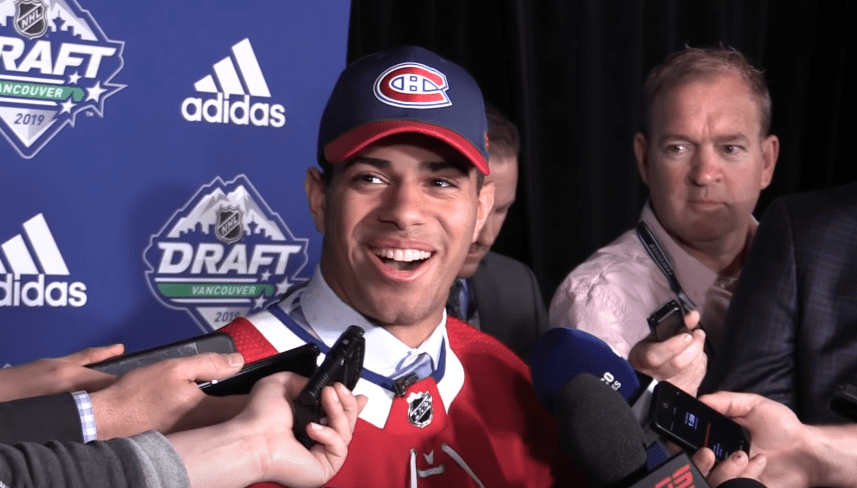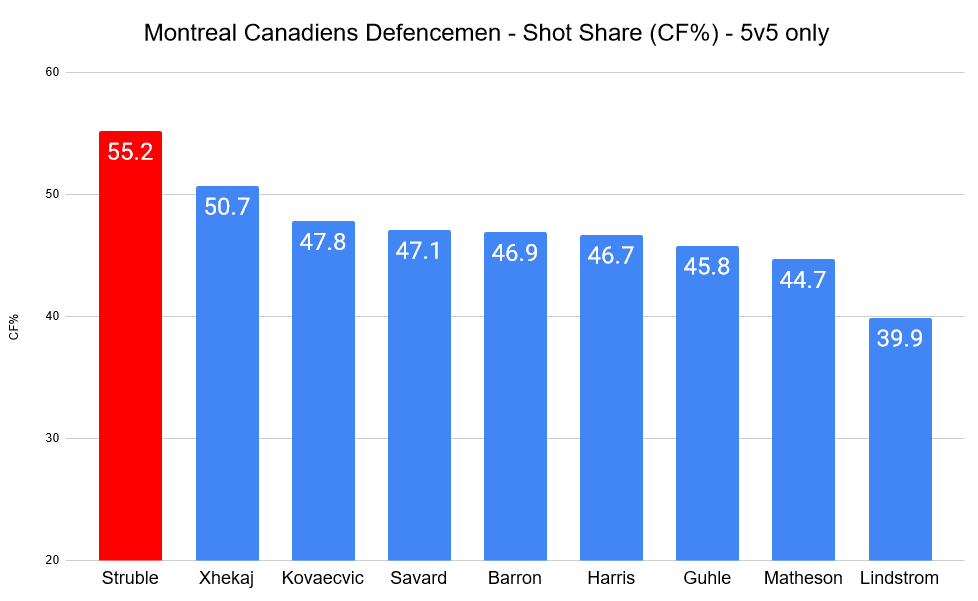Canadiens Analysis
Habs Stats Pack – Evaluating Jayden Struble’s NHL Start

The Montreal Canadiens were expecting prospect Jayden Struble to find his rhythm in the AHL this season, with an outside chance that he’d play a few games in the NHL.
Fast forward a few months later, and not only has Struble already playing in the NHL, but his transition has been virtually seamless.
To get a better idea of his impact, we’re going to take a look at some of his underlying numbers. We must remember that the sample size is relatively small, and things can change quickly, but for now, here’s what Struble has managed to do in the NHL.
Shot Share
Before we jump into the numbers, we should establish what Struble brings to the table for the Canadiens.
First off, he’s keeping things simple. He’s not putting himself into precarious situations by jumping into the play constantly. He has joined the rush occasionally, but he’s picked his spots quite well.
In addition, Struble has shown he can overpower his opponents in board battles, which leads to quick puck retrievals and consequently, controlled exits.
This is particularly important for a team like the Canadiens that struggles when it comes to efficient puck retrievals. You’d be hard-pressed to only blame the defencemen for the issue. Forwards must do a better job supporting their defencemen as well as giving the teammates pass options to break out of the defensive zone.
But when Struble is on the ice, the Canadiens are a much better team in transition due to his skill set.
He also keeps it quite simple when he has the puck in the offensive zone. Given his history, I’d argue he’s holding back a little, and that’s perfectly fine for a player just seven games into his NHL career. On that note, we do know he can be a lot more active, as was the case when he played for Northeastern.
But for now, he’s wisely avoiding any complicated plays, and the results have been very encouraging.
Jayden Struble didn't have to do anything spectacular tonight. He just needed to play a smart, efficient game, and he did exactly that.
Good NHL debut. pic.twitter.com/v4prueQ1q6
— Marc Dumont (@MarcPDumont) November 23, 2023
To get a better idea of his impact, we can check the underlying numbers of his two most common defensive partners: Johnathan Kovacevic and Gustav Lindstrom.
When Kovacevic is paired with Struble, they control almost 56 percent of the shots. And when Lindstrom played with him, they had an impressive 55.2 percent control of the shots.
Those are excellent results, even if Struble is playing a more sheltered role on the third pairing.
And here’s where his impact truly shines.
Without Struble, Kovacevic has only controlled 46.5 percent of the shots—a significant downtick. As for Lindstrom, his numbers dip even further. He’s only managed to control a little over 37 of the shots without Struble.
Essentially, when he plays with Struble his numbers are well above average, but without him, his numbers are well below replacement.
Lindstrom’s usage plays a part in this decline, but it’s impossible to ignore that Struble has made defensive partners better, and that’s quite uncommon for a young defenceman with very little professional experience.
To drive the point home, we can look at all the defencemen’s shot control (Corsi For Percentage) this season.
Again, we have to keep in mind the usage. Mike Matheson is playing on the top pairing, and there’s no doubt that’s a more difficult assignment than playing limited minutes on the third pairing.
But even if we mind the usage, Struble has done a very good job in his limited ice time. He leads the Canadiens in shot share by a fairly significant margin.
His greatest asset is his offensive impact, believe it or not.
When Struble is on the ice, the Habs take more shots than when any other defenceman is playing.
Diving Deeper
A team taking lots of shots when a particular player is on the ice is a good sign, but it’s not always the best indicator of future success.
To better understand what we can expect from Struble, we have to look at his expected goals percentage (xGF%).
That measures things such as shot location, shot types, competition, and more to get a better idea of whether a player’s numbers are sustainable moving forward.
As it stands, only Arber Xhekaj has produced a better expected-goals percentage than Struble.
The two defencemen share a similar profile. Both Xhekaj and Struble are among the strongest players in the league, and they can both dominate their opponents in puck battles.
But their value comes from two very different aspects of the game.
Xhekaj is the team’s best shutdown player statistically speaking, whereas Struble is the best defenceman when it comes to making an impact at the other end of the rink.
Simply put, his efficient style of play usually leads to sustained offensive zone presences for the Montreal Canadiens.
Defencemen Jayden Struble and Johnathan Kovacevic take matters into their own hands.
Kovacevic with a great snipe to put the #Habs on the board.
It's Struble's first NHL point. pic.twitter.com/XfyHKXNRIK
— Marc Dumont (@MarcPDumont) November 24, 2023
Brass Tacks
Some have suggested that Struble is a perfect replacement for Xhekaj, but I’d push back against that opinion given that they have produced excellent underlying numbers via different avenues.
They’re two very different players when it comes to their style of play.
And yet, they’ve both managed to make a positive impact while playing on the third pairing.
Granted, it opens up options for the Montreal Canadiens, but given the team’s struggles in the defensive zone, not to mention their endless stream of injuries, we should be cautious when suggesting a player with just seven games of experience in the NHL can replace a player of Xhekaj’s ilk.
More than anything, Canadiens fans should be happy knowing they have two defencemen available who can produce good results in limited minutes, all the while playing the truculent brand of hockey that General Manager Kent Hughes tends to encourage.
It’s very rare, especially for physical defencemen such as Jayden Struble.
All Montreal Canadiens statistics are 5v5 unless otherwise noted. Via Natural Stat Trick.












